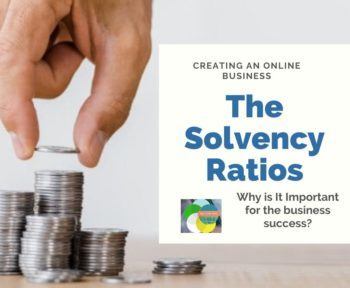It is a usual case that companies always have a debt factor as it doesn’t run only on the owner’s fund. The debt factor can be loans, debentures, deposits, etc. Therefore one needs to keep a check on the cost of such debts. One should even be aware that the company is capable of meeting such expenses. Thus, in this case, the solvency ratios are useful.
One can define solvency ratio as the ability of an entity to service its debt. The Solvency Ratios are also known as Leverage Ratios.
Thus one requires calculating these ratios when the company meets its long term debt.
It is necessary for calculating the solvency ratio of a firm for informing the investors about the solvency of the firm. The company provides this information to investors to meet their interest payments, along with ensuring that their investments are safe.
Therefore the solvency ratios help in comparing the levels of fixed assets, debt with equity, earnings of the company, etc.
But one should be clear about the concept of Solvency ratios and Liquidity ratios. Liquidity ratios compare the current assets with the current liabilities that define to be short term debt.
Whereas, one analyzes the ability to pay long term debts through solvency ratios.
What Is Solvency Ratios?
One can define solvency ratios as the matrix that calculates the financial position of an organization considering its debt status. An enterprise uses this matrix to measure its ability to meet debt obligations.
Then, it is a popular measuring instrument for prospective business leaders. This ratio indicates the status of the sufficiency of the cash flow of a company for meeting its long term and short term liabilities.
Therefore, with the lower solvency ratios of a company, the probability of getting default on its debt obligation increases.

A company’s investors closely track these ratios to understand the ability of business for meeting its long term liabilities.
This helps them in defining the solvency meaning and even making decisions for long term investment in the business.
What Are The Definition Of Solvency Ratio?
One can define a solvency ratio in several ways. So, a solvency ratio is the measure of the extent to which the company’s assets commit to future payments and liabilities. For an insurance company, the solvency ratio is the size of its capital relative to all the taken risks.
If we define solvency ratio in mathematical terms as solvency definition, that is the currents assets divided by current liabilities.
This mathematical formula indicates the ability to pay for existing liabilities. This takes place on proceeding from the liquidation of current assets.
The solvency ratio or financial solvency also provides the measure of the size of a company’s income after tax.
It does not count on the non-cash depreciation expenses in contrast to the total debt obligations of the firm.
Importance Of Solvency Ratios For A Successful Business
The solvency ratio is an essential element for the long run business. It is a crucial part of a financial analysis of a company. It determines whether the company has sufficient cash flow for managing its debts as they come due.
Solvency ratios are highly necessary for assessing the risk of meeting all the financial obligations of a company.
Companies with a lower score of solvency ratios are often seen to pose a higher risk to creditors and banks. One can consider a company to be healthy with a solvency ratio of 0.5.
How Is Solvency Ratio Used?
An enterprise or prospective business lenders use the solvency ratio as a key metric. They use it to measure its ability to meet the dead obligations of the company.
With the help of the solvency ratio, one can estimate the status of the cash flow of a company.
It measures whether the cash flow is sufficient to meet short and long term liabilities. A company often uses the concept of solvency ratio as a measuring gauge of the financial health of the company.
For tracking the solvency ratio of a business, one can express it in the form of the formula.
Thus solvency ratio = (net income after tax + non cash expenses) / all liabilities.
Through this formula, the periodical checking of a business’s solvency ratio helps in ensuring the company’s fiscal health.
What Is Solvency Ratio Good For?
The business organization considers the solvency ratio suitable for measuring the fiscal health of a company.
This measuring ratio provides the investors of business concrete information about a company’s position to meet its debt obligations.
The higher the solvency ratio, the more is the financial strength of the business. The solvency ratios are of high interest to the shareholders as well as long term creditors.
How To Endorse A Business Through Solvency Ratio?
In consideration, the solvency ratio is a metric that measures the size of the profitability of a company.
This measurement is compared to the debt obligations of the company. An investor interprets a solvency ratio in gaining insight into how a company can meet its debt obligations.

With a lower solvency ratio, a company indicates financial struggles in the future. Based on the cash profitability of a firm, one should calculate the solvency ratio.
Type Of Solvency Ratio.
There are three types of solvency ratios, which are Debt to equity, Total debt to total assets, and Interest coverage ratios. So, the Debt to equity ratio indicates the measure of total debt as compared to the equity of the shareholders.
Then, the total debt to total assets is the ratio of short term and long term liabilities compare to the total holdings of a firm. The Interest coverage ratios measure the company’s ability to keep up with interest payments that rise along with outstanding debts.
How It Solves Your Financial Woes?
Improving the solvency ratio of a company can help in solving the financial woes.
Then, the improvement of the solvency ratio also boosts the profitability of a company in the long term. One can do this while improving the Debt to total asset ratio.
Thus, trying to increase the sales of a company might help to offset any debt of the company.
This makes the solvency ratio more appealing to investors. The other ways are issuing new stocks for boosting cash flow, avoiding new debt along with increasing owner equity.
Competitive Perspective Of Solvency Ratio In A Business
The solvency ratios have substantially beneficial effects on business as it affects the ability to get loans from banks. And it also helps in forecasting the company’s financial health in the coming years.
So, the competitive perspective lies in the accurate calculation or estimation of the solvency ratio of a business.
Through the accurate numbers of solvency ratio, one can have a thorough understanding of the company’s finances. This might help form becoming insolvent in the future.
How To Improve Your Solvency?
One can improve the solvency ratio by boosting the profitability of the firm in the long term while improving the Debt to total assets ratio.
Then, further ways that can improve the solvency ratios are by re-evaluating the operating expenses along with looking for bulk discounts.
Apart from this, increasing the owner equity and avoiding new debt for the company can also be the other ways.
Keep Solid With Solvency.
For avoiding becoming insolvent in the recent future, a company should accurately calculate its solvency ratio.

Then, on accurately estimating the solvency ratios, one can have a thorough understanding of the financial position of a company.
Solvency ratios help in forecasting the fiscal health of a company in the coming years.
Conclusion
From the above article, we can have an extensive view of the solvency ratios. Then, we had a clear understanding of the importance of the utilization of the solvency ratios in a business.
So, it is an essential metric for the investors and money lenders of a business.
The popper calculation of solvency ratio of a company helps the investors to understand the financial status of that company.
Do you think a solvency ratio is a crucial tool for assessing the status of a business? if you have suggestions or comment on this regard, I appreciate your valuable ideas









